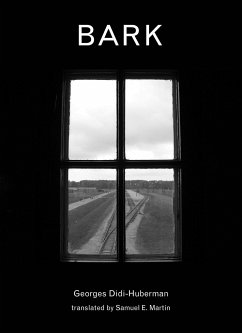A noted French thinker's poignant reflections, in words and photographs, on his visit to Auschwitz-Birkenau.
On a visit to Auschwitz-Birkenau, Georges Didi-Huberman tears three pieces of bark from birch trees on the edge of the site. Looking at these pieces after his return home, he sees them as letters, a flood, a path, time, memory, flesh. The bark serves as a springboard to Didi-Huberman's meditations on his visit, recorded in this spare, poetic, and powerful book. Bark is a personal account, drawing not on the theoretical apparatus of scholarship but on Didi-Huberman's own history, memory, and knowledge.
The text proceeds as a series of reflections, accompanied by Didi-Huberman's photographs of the visit. The photographs are not meant to be art Didi-Huberman confesses that he photographed practically everything without looking but approach it nevertheless. Didi-Huberman tells us that his grandparents died at Auschwitz, but his account is more universal than biographical. As he walks from place to place, he observes that in German birches are birken; Birkenau designates the meadow where the birches grow. Didi-Huberman sees and photographs the reconstructed execution wall; the floors of the crematorium, forgotten witnesses to killing; and the birch trees, lovely but also resembling prison bars. Taking his own photographs, he thinks of the famous photographs taken in 1944 by a member of the Sonderkommando, the only photographic documentation of the camp before the Germans destroyed it, hoping to hide the evidence of their crimes. Didi-Huberman notices a bizarre proliferation of white flowers on the exact spot of the cremation pits. The dead are not departed.
Hinweis: Dieser Artikel kann nur an eine deutsche Lieferadresse ausgeliefert werden.
On a visit to Auschwitz-Birkenau, Georges Didi-Huberman tears three pieces of bark from birch trees on the edge of the site. Looking at these pieces after his return home, he sees them as letters, a flood, a path, time, memory, flesh. The bark serves as a springboard to Didi-Huberman's meditations on his visit, recorded in this spare, poetic, and powerful book. Bark is a personal account, drawing not on the theoretical apparatus of scholarship but on Didi-Huberman's own history, memory, and knowledge.
The text proceeds as a series of reflections, accompanied by Didi-Huberman's photographs of the visit. The photographs are not meant to be art Didi-Huberman confesses that he photographed practically everything without looking but approach it nevertheless. Didi-Huberman tells us that his grandparents died at Auschwitz, but his account is more universal than biographical. As he walks from place to place, he observes that in German birches are birken; Birkenau designates the meadow where the birches grow. Didi-Huberman sees and photographs the reconstructed execution wall; the floors of the crematorium, forgotten witnesses to killing; and the birch trees, lovely but also resembling prison bars. Taking his own photographs, he thinks of the famous photographs taken in 1944 by a member of the Sonderkommando, the only photographic documentation of the camp before the Germans destroyed it, hoping to hide the evidence of their crimes. Didi-Huberman notices a bizarre proliferation of white flowers on the exact spot of the cremation pits. The dead are not departed.
Hinweis: Dieser Artikel kann nur an eine deutsche Lieferadresse ausgeliefert werden.
Bark is a slim, poignant, controlled narrative, yet is presented as an irrepressible and unpremeditated stream of writing. Guylaine Massoutre, Le Devoir
Bark is the exploration of a gaze, and the exploration, through looking, of what is looked at. What is looked at are photographs, as well as a place: Auschwitz-Birkenau.
Jean-Philippe Cazier, Mediapart
Bark is the exploration of a gaze, and the exploration, through looking, of what is looked at. What is looked at are photographs, as well as a place: Auschwitz-Birkenau.
Jean-Philippe Cazier, Mediapart
Bark is a slim, poignant, controlled narrative, yet is presented as an irrepressible and unpremeditated stream of writing. Guylaine Massoutre, Le Devoir
Bark is the exploration of a gaze, and the exploration, through looking, of what is looked at. What is looked at are photographs, as well as a place: Auschwitz-Birkenau.
Jean-Philippe Cazier, Mediapart
Bark is the exploration of a gaze, and the exploration, through looking, of what is looked at. What is looked at are photographs, as well as a place: Auschwitz-Birkenau.
Jean-Philippe Cazier, Mediapart








